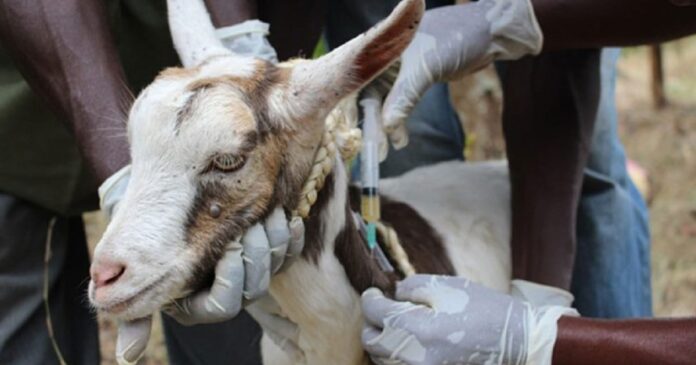What most livestock farmers worry about are diseases. Diseases of livestock increase the cost of production and reduce the quality of meat. They also reduce income and sometimes may cause the collapse of a whole livestock production business.
In many cases, livestock diseases are preventable by applying very simple precautionary measures. Livestock farmers must know the causes of livestock diseases and the possible easiest ways to prevent them.
What Causes Livestock Diseases?
Diseases cause dysfunctioning of the body of the livestock. Poor sanitation and improper management can spread diseases. Also, the introduction of new animals into a herd.
Throwing more light on the causes of livestock diseases.
1. Nutritional deficiency
Livestock needs balanced food nutrients in their ration. If not they can cause nutritional defects. If the livestock gets inadequate amounts of vitamins, minerals, fats, carbohydrates, and protein it cannot produce well. This reduces its ability to fight diseases.
Read also: 14 Major Chicken Diseases, Symptoms, Prevention and Treatments
2. Physiological defects
Physiological defects include glands, organs and/or body system not working well. A good diet will help the proper functioning of the body parts. For example, the thyroid gland regulates the rate of body metabolism. It depends on enough supply of iodine to function properly. A thyroid gland this is not working well will cause the animals to need more nutrients. This means there will not be enough nutrients for growth or production.
3. Morphological or Physical defects
Cuts, scrapes, scratches, bruises, and broken bones are all morphological defects. An accident or negligence can cause physical defects. Any one of these can temporarily or permanently reduce the efficiency of an animal. To prevent it you need good management practices. Read on to know more about good management practices.
Read also: Detailed Guide to Layer Production in Ghana from the experts
4. Pathogenic defects
Certain organisms produce toxins or poisons. The toxins and poisons disturb the normal metabolic activity of the animal. Viruses and bacteria are the most common organisms causing diseases. They are not seen with naked eyes. They are able to multiply very fast under favourable conditions. Other pathogens are fungi and protozoans. Let us look at each type.
- Viral diseases
- Bacterial diseases
- Fungal diseases
- Protozoa
Read also: Detailed Steps on How to Start a Farm
Preventive Measures and Good Management Practices
Having said much about the causes of livestock diseases, let us look at the preventive measure.
Prevention is the key and the best way to control animal diseases. Sanitation is the key to prevent diseases. Most disease-causing organisms enter the body through a body opening. Opening such as the nose, eyes, mouth, or wound incision. Pathogens spread by direct contact. Also, indirectly by the wind, water, feed, or other animals. After entering the host (animal), a pathogen must overcome the natural resistance of the body. Then produce the disease.
In summary, Prevent livestock disease with Good Sanitation.
Here are some management practices for controlling livestock diseases.
Housing
- Prevents pathogens from growing in the housing (good sanitation).
- Give enough space for all animals. Crowded conditions promote diseases.
- Good ventilation for fresh air and temperature control.
- Remove nails sticking out and broken boards.
- Provide good drainage. Keep floors and pens dry and clean. Also, keep bedding fresh and dispose of manure often.
- Provide clean surroundings.
- Also, the use of disinfectants. Use chemicals that prevent the growth of pathogens..
- Separate different classes of livestock with partitions.
- Protect livestock from severe weather.
Feeding
- Feed your livestock well with a balanced diet.
- Pasture rotation system. This method helps to control disease and parasites. Divide the pasture areas into several areas. Allow the livestock to graze in one area at a time in rotations. It breaks the life cycle of pathogens. In addition, the ultraviolet rays of sunlight kill pathogens when the livestock are not in it.
Biosecurity and medication
- Before you introduce animals into the herd, isolate them for 3-4weeks. This
includes new animals and those you have removed from the herd and exposed to other animals. - Follow a sound immunization program.
- Do not allow visitors and new animals in the livestock area. If you must, make sure you disinfect them.
- Scout regularly for diseases. Diagnose quickly and accurately.
- Consult a competent veterinary officer when there is a health problem.
- Use canvas slappers, rather than clubs and whips.
Trucks and machinery
- Remove machinery and equipment from the lot.
- Bed barns and trucks properly.
- Load animals slowly and carefully
Regulation
- Government regulations can help control the transportation and sale of livestock. Local veterinary officers also help farmers to put up a disease prevention program. They are also, source of information on government regulations on livestock production.
Read also: Compost: Composting Steps, Materials and Importance
In conclusion
Proper management practices and prevention measures reduce livestock diseases. And so, a profitable livestock venture. Consult a local veterinary officer and learning more about diseases. You can also learn a lot from this blog.
Reference:
Causes, Symptoms, Prevention and Treatment of Various Animal Diseases (birdvilleschools.net)


